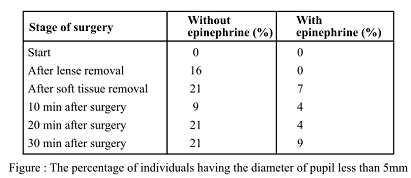
To review:
The part of the iris that is affected by the epinephrine injection, on the basis of experimental results obtained from the surgeries performed with or without epinephrine.
Given:
A cataract refers to the clouding of lens that can occur either due to exposure to ultraviolet light or due to aging. The eye lens in this condition becomes cloudy and nontransparent. For the proper sight, the cataract that is the cloudy lens needs to be removed by the surgeon. In doing so, the surgeon has to make sure that pupil is dilated properly and for a longer time. The dilation of the pupil is controlled by adrenal medulla that releases epinephrine and norepinephrine.
Researchers conducted an experiment to deduce if epinephrine can help in keeping the pupil dilated for a longer time during cataract surgeries. They injected epinephrine into the eye of 27 patients for cataract surgery and did not inject in the eyes of 43 other patients that were also taken into consideration.
The table data shows the patients percentage whose eyes had the pupil diameter size less than 5 mm during the different stages of cataract surgery:

Introduction:
The eye is an important vision organ and its improper functioning causes loss of sight. To cure cataract, which is a disease where the lens of the turns a bit cloudy and nontransparent, people go to surgeons for different surgeries. For the surgery to take place properly, the pupil which is a opening in iris of eye should be properly dilated. The pupil dilation is controlled by various hormones.
Explanation of Solution
Iris forms the major part of the eye, is a thin and circular aperture and is responsible for the contraction and dilation of the pupil of eye. Along with the two types of muscles that constitute the iris, pupil is present. The pupil is responsible for the amount of light that reaches the retina of eye. The size of the pupil is variable and can increase or decrease according to the amount of light to be perceived. It is controlled by the hormone epinephrine that helps in its dilation, which in turn, helps in the better perception of light.
During the experiment, epinephrine (which was injected into the patient’s eye for cataract surgery) dilated pupil and helped in the surgery. Thus, the injected epinephrine affects the pupil of the eye causing it to dilate and increasing in size. The increase in size makes it easier for the surgeons to carry out the surgery. It is clearly evident by the results of the two cases that epinephrine injected patients have less percentage of those having pupil diameter <5 mm while the patients that were not injected by epinephrine have a larger percentage at all the stages of surgery. Epinephrine controlled the diameter of pupil and injected patients pupil remain dilated during the surgery.
Hence, it can be concluded that pupil is the smallest opening in the iris of the eye, which is affected when epinephrine is injected into the patients. The presence of epinephrine in the eye causes the pupil to dilate and increase in size while the absence of epinephrine keeps the size of the pupil small as interpreted from the experiment’s data.
Want to see more full solutions like this?
Chapter 40 Solutions
LIFE:SCIENCE OF BIOL.(LL) >CUSTOM<
- 18. Watch this short youtube video about SARS CoV-2 replication. SARS-CoV-2 Life Cycle (Summer 2020) - YouTube.19. What is the name of the receptor that SARS CoV-2 uses to enter cells? Which human cells express this receptor? 20. Name a few of the proteins that the SARS CoV-2 mRNA codes for. 21. What is the role of the golgi apparatus related to SARS CoV-2arrow_forwardState the five functions of Globular Proteins, and give an example of a protein for each function.arrow_forwardDiagram of check cell under low power and high powerarrow_forward
- a couple in which the father has the a blood type and the mother has the o blood type produce an offspring with the o blood type, how does this happen? how could two functionally O parents produce an offspring that has the a blood type?arrow_forwardWhat is the opening indicated by the pointer? (leaf x.s.) stomate guard cell lenticel intercellular space none of thesearrow_forwardIdentify the indicated tissue? (stem x.s.) parenchyma collenchyma sclerenchyma ○ xylem ○ phloem none of thesearrow_forward
- Where did this structure originate from? (Salix branch root) epidermis cortex endodermis pericycle vascular cylinderarrow_forwardIdentify the indicated tissue. (Tilia stem x.s.) parenchyma collenchyma sclerenchyma xylem phloem none of thesearrow_forwardIdentify the indicated structure. (Cucurbita stem l.s.) pit lenticel stomate tendril none of thesearrow_forward
- Identify the specific cell? (Zebrina leaf peel) vessel element sieve element companion cell tracheid guard cell subsidiary cell none of thesearrow_forwardWhat type of cells flank the opening on either side? (leaf x.s.) vessel elements sieve elements companion cells tracheids guard cells none of thesearrow_forwardWhat specific cell is indicated. (Cucurbita stem I.s.) vessel element sieve element O companion cell tracheid guard cell none of thesearrow_forward
 Principles Of Radiographic Imaging: An Art And A ...Health & NutritionISBN:9781337711067Author:Richard R. Carlton, Arlene M. Adler, Vesna BalacPublisher:Cengage Learning
Principles Of Radiographic Imaging: An Art And A ...Health & NutritionISBN:9781337711067Author:Richard R. Carlton, Arlene M. Adler, Vesna BalacPublisher:Cengage Learning Human Physiology: From Cells to Systems (MindTap ...BiologyISBN:9781285866932Author:Lauralee SherwoodPublisher:Cengage Learning
Human Physiology: From Cells to Systems (MindTap ...BiologyISBN:9781285866932Author:Lauralee SherwoodPublisher:Cengage Learning Biology: The Dynamic Science (MindTap Course List)BiologyISBN:9781305389892Author:Peter J. Russell, Paul E. Hertz, Beverly McMillanPublisher:Cengage Learning
Biology: The Dynamic Science (MindTap Course List)BiologyISBN:9781305389892Author:Peter J. Russell, Paul E. Hertz, Beverly McMillanPublisher:Cengage Learning





